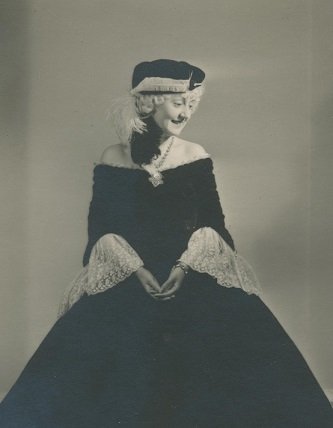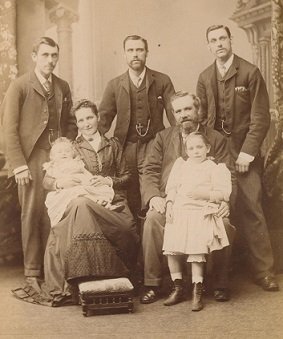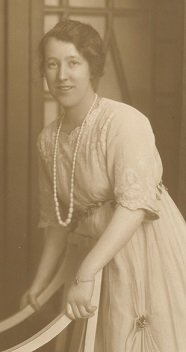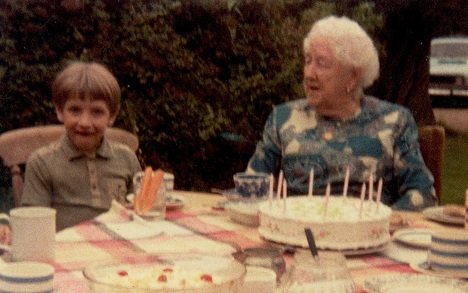
Using a chest of photos of dead relatives to peer into the recent past was proving insightful. Following my initial one-box, 698-image investigation of the Ancestor Chest, I had a detailed sense of the pictures it contained.
Mainly, it was photos of:
- the Donnelly family (Mum’s maternal family), from the 1860s to the early twentieth century;
- the Marsh family (Mum’s paternal family), from the 1880s to the 1970s;
- the Baker family (Dad’s family) from 1946 to the 1970s, with a smidgen back to c. 1910; and
- our Baker-Marsh clan, and its myriad associates, from the 1970s to around 2005.
Back to the Ancestor Chest
On a weekend when Claire was visiting her mother, I took a trip to East Anglia loaded-up with two hemp shopping bags, specially acquired document boxes and a wheelie case. I arrived at the storage in Lawford – where the Ancestor Chest lived – on Saturday afternoon, rolled-up my sleeves and went at it with purpose.
This time I went right to the bottom. It took two hours. I sorted the entire contents, stripping-out the detritus of old card, battered picture frames, broken glass and nonsense. The chaff separated, I packed the wheat into boxes: a thousand more photos, bags and tins of letters and documents, plus a glass-framed portrait of a man who, I learned later that afternoon, was my great grandfather ‘Jon the Don’.
By the end – the wheely case stuffed with boxes stuffed with photos and letters, plus two hemp bags full to the brim – I was at the edge of what I could carry, while limited to slow, short waddles between trains. The chest was empty, and off I went to visit cousin Donna in Dunwich.
Production Line, Part 2
On returning to the leg work, I first went through everything I’d extracted from the Ancestor Chest and separated the photographs (this project) from the letters and documents (for another time).
For the photos, I’d developed some skill in turning a mound of loose, unsorted photographs into a methodical set of albums in the cloud. I had a worked-out production line. Through the following spring and summer, I cranked its handle whenever I had a spare hour …
- Sort the unsorted photos into piles
- Scan the piles
- Crop the scans
- File the cropped images
- Upload the files
The confused physical morass I’d begun with gradually gave rise to an ordered set of online albums.
Disorder, Meet Order
As I closed in on order, I noted that the tail-end of the pictures in the chest over-lapped with Mum and Dad’s actual photo albums. These I posted to a company which cropped and scanned them for me, and added the images (on the USB stick which came back) to the master files.
Finally, to ensure I was doing a one-off job that never need repeating, I gathered up the negatives from father’s single-reflex camera and posted them to be scanned by a different set of professionals. Unturned stones would not be left.
After the images from the Ancestor Chest, photo albums, and negatives had all been compiled into cloud-based master files, and duplicates weeded out, I was left with a total of 2,195 images. These I copied, en masse, to Flickr – my photo-sharing platform of choice. I then re-ordered the photos in those albums into chronological or engaging arrangements, and did some labelling.
And from there, those albums will form a free-to-access record for posterity, of the Donnelly, Marsh, and Baker families from 1867 to 2010, instantly available from anywhere in the world, for the rest of history.
Job done.

Twenty-First Century Photo Tech
Twenty-five years ago, a project like this would have been laborious, clunky and required hard-to-share and slow-to-access physical albums. Today, all the resources are readily available and nearly costless: a cheap scanner commandeered from my friend Tony (ergo: free) for the photo-imaging, Windows Viewer (free) for photo-examining, Microsoft Paint (free) for photo-cropping, and Flickr (a small annual subscription which I already paid, so basically free) for photo-displaying. The only monetary costs were at the end – paying companies to scan the albums and negatives.
It’s testament to the enabling capacity of a massively diversified modern economy, and the empowering force of the technological revolution that what looked like a sticky problem (a 100-year-old chest, jumbled with a century of stuff) could be turned into a systematic online record with a bit of focus and organisation over some weekends.
Photographs As Time Capsules
The final computer-screen-displayed pictures never quite do justice to the endorphin rush of uncovering a 130-year-old photographic plate, last handled before one was born, by a grandparent one never knew.
A Victorian family portrait taken to mark a new birth, when photographs were rarer and more precious than today, was presumably much-discussed, treasured and cooed-over in the years after it’d been taken. A moment in time, captured. A familiar artefact: skilfully composed, undeniably beautiful.
Then, decade following decade, it falls into obscurity, its familiarity fading as the years roll by and it’s moved between household storage spaces. The subjects depicted, one-by-one, grow old and die. Then the people who might recognise them start to die.
One hundred and thirty years later that once-familiar object ends up in the hands of the great grandson of the person who originally organised the photo. A great grandson who has only a vague idea where it comes from, and who’s left peering at a rough family tree to make sense of it. But the photo still exudes intimacy, and the sense that, at the time it was taken, it captured something which was contemplated with emotion and richly remembered; a time capsule.

Special mention to Edith Marsh (1891 to 1985), a.k.a “Aunty Paddy”, my maternal grandfather’s elder sister. Due to her 94-year life, Edith made it from those formal, posed, nineteenth-century Victorian shots all the way to the 1980s which, to my generation, feels almost contemporary. At either end of her lifespan lies a completely changed cast of characters and a hugely different world.
I remember Edith quite well, from a time when she was very old and I was very young. Enough of a crossing for me to recall and understand her essence. It’s testament that, even though we may not be at our most productive during our final years, simply surviving on the scene longer than one’s contemporaries projects one’s influence a generation deeper into the future – I think of Dad, who outlived Mum by six and a half years: sufficient that his granddaughters will carry living memory of him 40 years further into this century.
There is a single picture of Edith and I together, taken on the lawn at Earlings, the old family home. She is celebrating what I believe was her 91st birthday. I’m seven, in my unmindful seven-year-old world. When I look at that photo now, all I can think of is how many questions I’d have for Edith if I could speak to her now; if I could only go back.


Behind it stretches an immense chain of physical and –
as a special class within the whole – mental events,
to which it belongs as a reacting member
and which it carries on.
― Erwin Schrödinger
All their importance is underground.
― Winston Graham
More from me:
My book (UK)
My book (US)
My website
Hi! I am a robot. I just upvoted you! I found similar content that readers might be interested in:
http://thejollypilgrim.org/2018/05/53-photos-of-dead-relatives/
Downvoting a post can decrease pending rewards and make it less visible. Common reasons:
Submit
Welcome thejollypilgrim!
eSteem is the application that improves your experience on Steem. You have full control over your data and content, unlike some apps we don't use our users to promote our application or services.
We have Mobile application for Android and iOS users. We also have developed Surfer Desktop application that helps you to gain new followers and stay connected with your friends, unique features - notifications, bookmarks, favorites, drafts, and more.
We reward our users with encouragement upvotes as well as monthly giveaways rewarding Spotlight top users and active Discord users.
Learn more: https://esteem.app
Join our discord: https://discord.gg/8eHupPq
Downvoting a post can decrease pending rewards and make it less visible. Common reasons:
Submit
Hello, welcome to Steem. I hope you would enjoy it here as much as I do.
I will recommend you to use the partiko mobile app for an amazing experience on Steem.
Download the app with my referral link https://partiko.app/referral/akomoajong
Once you download the app and login, I will delegate 15SP to help your journey on Steem for a week.
Posted using Partiko Android
Downvoting a post can decrease pending rewards and make it less visible. Common reasons:
Submit
Welcome to steemit @thejollypilgrim.
Welcome the new steemians. Have a great day!
Downvoting a post can decrease pending rewards and make it less visible. Common reasons:
Submit
Hey I am loving these posts :) Would you mind confirming ownership of this content by adding a backlink to your Steem blog on your website? Cheers
Downvoting a post can decrease pending rewards and make it less visible. Common reasons:
Submit
Hi Carl
Apologies for the delay in responding. I will add a Steemit link to my website. (Give me a day or two). Appreciate your work curating and checking.
Many thanks
Peter
Downvoting a post can decrease pending rewards and make it less visible. Common reasons:
Submit
No problem at all, thanks for confirming on Facebook :) I hope this means you will be posting more, I really enjoyed your first few posts! I will try to keep an eye out but if you make a post, feel free to let me know in a reply to this comment so I can make sure to help promote it for you :)
Downvoting a post can decrease pending rewards and make it less visible. Common reasons:
Submit